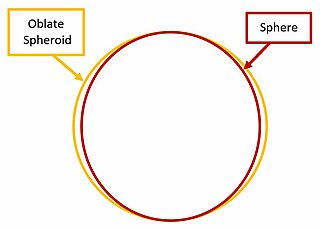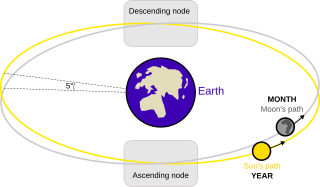
Tidal acceleration is an effect of the tidal forces between an orbiting natural satellite and the primary planet that it orbits. The acceleration causes a gradual recession of a satellite in a prograde orbit, and a corresponding slowdown of the primary's rotation. The process eventually leads to tidal locking, usually of the smaller body first, and later the larger body. The Earth–Moon system is the best-studied case.

Tides are the rise and fall of sea levels caused by the combined effects of the gravitational forces exerted by the Moon and are also caused by the Earth and Moon orbiting one another.

The tidal force or tide-generating force is a gravitational effect that stretches a body along the line towards and away from the center of mass of another body due to spatial variations in strength in gravitational field from the other body. It is responsible for the tides and related phenomena, including solid-earth tides, tidal locking, breaking apart of celestial bodies and formation of ring systems within the Roche limit, and in extreme cases, spaghettification of objects. It arises because the gravitational field exerted on one body by another is not constant across its parts: the nearer side is attracted more strongly than the farther side. The difference is positive in the near side and negative in the far side, which causes a body to get stretched. Thus, the tidal force is also known as the differential force, residual force, or secondary effect of the gravitational field.

Orbital inclination measures the tilt of an object's orbit around a celestial body. It is expressed as the angle between a reference plane and the orbital plane or axis of direction of the orbiting object.

Tidal locking between a pair of co-orbiting astronomical bodies occurs when one of the objects reaches a state where there is no longer any net change in its rotation rate over the course of a complete orbit. In the case where a tidally locked body possesses synchronous rotation, the object takes just as long to rotate around its own axis as it does to revolve around its partner. For example, the same side of the Moon always faces the Earth, although there is some variability because the Moon's orbit is not perfectly circular. Usually, only the satellite is tidally locked to the larger body. However, if both the difference in mass between the two bodies and the distance between them are relatively small, each may be tidally locked to the other; this is the case for Pluto and Charon, as well as for Eris and Dysnomia. Alternative names for the tidal locking process are gravitational locking, captured rotation, and spin–orbit locking.

An equatorial bulge is a difference between the equatorial and polar diameters of a planet, due to the centrifugal force exerted by the rotation about the body's axis. A rotating body tends to form an oblate spheroid rather than a sphere.

A lunar node is either of the two orbital nodes of the Moon, that is, the two points at which the orbit of the Moon intersects the ecliptic. The ascending node is where the Moon moves into the northern ecliptic hemisphere, while the descending node is where the Moon enters the southern ecliptic hemisphere.

In lunar astronomy, libration is the cyclic variation in the apparent position of the Moon perceived by Earth-bound observers and caused by changes between the orbital and rotational planes of the moon. It causes an observer to see slightly different hemispheres of the surface at different times. It is similar in both cause and effect to the changes in the Moon's apparent size due to changes in distance. It is caused by three mechanisms detailed below, two of which cause a relatively tiny physical libration via tidal forces exerted by the Earth. Such true librations are known as well for other moons with locked rotation.

An amphidromic point, also called a tidal node, is a geographical location which has zero tidal amplitude for one harmonic constituent of the tide. The tidal range for that harmonic constituent increases with distance from this point, though not uniformly. As such, the concept of amphidromic points is crucial to understanding tidal behaviour. The term derives from the Greek words amphi ("around") and dromos ("running"), referring to the rotary tides which circulate around amphidromic points. It was first discovered by William Whewell, who extrapolated the cotidal lines from the coast of the North Sea and found that the lines must meet at some point.

Physical oceanography is the study of physical conditions and physical processes within the ocean, especially the motions and physical properties of ocean waters.
A lunar standstill or lunistice is when the Moon reaches its furthest north or furthest south point during the course of a month. The declination at lunar standstill varies in a cycle 18.6 years long between 18.134° and 28.725°, due to lunar precession. These extremes are called the minor and major lunar standstills.

Earth's rotation or Earth's spin is the rotation of planet Earth around its own axis, as well as changes in the orientation of the rotation axis in space. Earth rotates eastward, in prograde motion. As viewed from the northern polar star Polaris, Earth turns counterclockwise.

The Moon orbits Earth in the prograde direction and completes one revolution relative to the Vernal Equinox and the stars in about 27.32 days and one revolution relative to the Sun in about 29.53 days. Earth and the Moon orbit about their barycentre, which lies about 4,670 km (2,900 mi) from Earth's centre, forming a satellite system called the Earth–Moon system. On average, the distance to the Moon is about 385,000 km (239,000 mi) from Earth's centre, which corresponds to about 60 Earth radii or 1.282 light-seconds.
Tidal heating occurs through the tidal friction processes: orbital and rotational energy is dissipated as heat in either the surface ocean or interior of a planet or satellite. When an object is in an elliptical orbit, the tidal forces acting on it are stronger near periapsis than near apoapsis. Thus the deformation of the body due to tidal forces varies over the course of its orbit, generating internal friction which heats its interior. This energy gained by the object comes from its orbital energy and/or rotational energy, so over time in a two-body system, the initial elliptical orbit decays into a circular orbit and the rotational periods of the two bodies adjust towards matching the orbital period. Sustained tidal heating occurs when the elliptical orbit is prevented from circularizing due to additional gravitational forces from other bodies that keep tugging the object back into an elliptical orbit. In this more complex system, orbital and rotational energy still is being converted to thermal energy; however, now the orbit's semimajor axis would shrink rather than its eccentricity.
Atmospheric tides are global-scale periodic oscillations of the atmosphere. In many ways they are analogous to ocean tides. Atmospheric tides can be excited by:

The equatorial electrojet (EEJ) is a narrow ribbon of current flowing eastward in the day time equatorial region of the Earth's ionosphere. The abnormally large amplitude of variations in the horizontal components measured at equatorial geomagnetic observatories, as a result of EEJ, was noticed as early as 1920 from Huancayo geomagnetic observatory. Observations by radar, rockets, satellites, and geomagnetic observatories are used to study EEJ.

New Zealand has large ocean energy resources but does not yet generate any power from them. TVNZ reported in 2007 that over 20 wave and tidal power projects are currently under development. However, not a lot of public information is available about these projects. The Aotearoa Wave and Tidal Energy Association was established in 2006 to "promote the uptake of marine energy in New Zealand". According to their 10 February 2008 newsletter, they have 59 members. However, the association doesn't list its members.
This glossary of astronomy is a list of definitions of terms and concepts relevant to astronomy and cosmology, their sub-disciplines, and related fields. Astronomy is concerned with the study of celestial objects and phenomena that originate outside the atmosphere of Earth. The field of astronomy features an extensive vocabulary and a significant amount of jargon.

Long-period tides are gravitational tides with periods longer than one day, typically with amplitudes of a few centimeters or less. Long-period tidal constituents with relatively strong forcing include the lunar fortnightly (Mf) and lunar monthly (Ms) as well as the solar semiannual (Ssa) and solar annual (Sa) constituents.
Tides in marginal seas are tides affected by their location in semi-enclosed areas along the margins of continents and differ from tides in the open oceans. Tides are water level variations caused by the gravitational interaction between the Moon, the Sun and the Earth. The resulting tidal force is a secondary effect of gravity: it is the difference between the actual gravitational force and the centrifugal force. While the centrifugal force is constant across the Earth, the gravitational force is dependent on the distance between the two bodies and is therefore not constant across the Earth. The tidal force is thus the difference between these two forces on each location on the Earth.

























